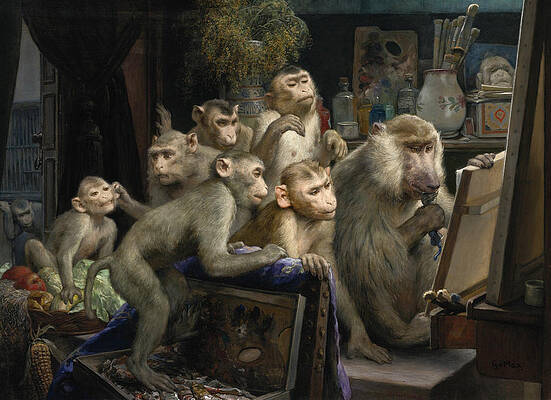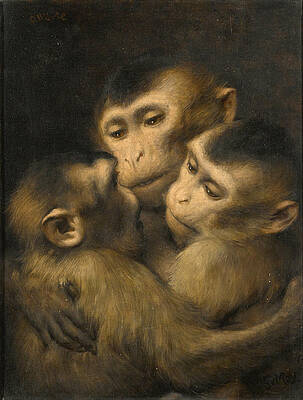Gabriel Cornelius von Max
Paintings
Three Monkeys






Gabriel Cornelius Ritter von Max (ennobled in 1900; 23 August 1840 – 24 November 1915) was a Prague-born Austrian painter.
Biography
He was born Gabriel Cornelius Max, the son of the sculptor Josef Max and Anna Schumann. He studied between 1855 and 1858 at the Prague Academy of Arts with Eduard von Engerth. His studies included parapsychology (somnambulism, hypnotism, spiritism), Darwinism, Asiatic philosophy, the ideas of Schopenhauer, and various mystical traditions. The spiritual-mystical movement was emphasized by the writings of Carl du Prel, and the Munich painter Albert Keller was also an influence.[1]
His first large canvas was painted in 1858 while he was a student at the Prague Academy. He continued his studies at the Viennese Academy of Art with Karl von Blaas, Karl Mayer, Christian Ruben and Carl Wurzinger. From 1863 to 1867 he studied at the Munich Academy with Karl Theodor von Piloty, and also Hans Makart and Franz Defregger. His first critical success was in 1867 with the painting "Martyr at the Cross": that painting transformed the "Unglücksmalerei" (dark palette) of Piloty into a religious-mystical symbolism using a psychological rendering of its subject.
Still Life (Girl at a Spinet) (1871)
He continued to use the dark palette of the Piloty school well into the 1870s, later moving toward a more muted palette, using fewer,clearer colors. From 1869, Gabriel von Max had his studio in Munich; in the summer, he was in the Ammerland at Starnberger Lake. From 1879-1883, Gabriel Max was a professor of Historical Painting at the Munich Academy; he also became a Fellow of The Theosophical Society. In 1900 he was ennobled and became a Ritter. He died in Munich in 1915.
His interest in anthropological studies also showed in his work. He owned a large scientific collection of prehistoric ethnological and anthropological finds: the collection and his correspondence now reside in the Reiss-Engelhorn-Museen in Mannheim. At his residence in Starnberger Lake, Gabriel Max surrounded himself with a family of monkeys, which he painted often, sometimes portraying them as human. Max, along with his colleagues, often used photographs to guide painting. The great number of monkey photographs in his archive testify to their use as direct translation into his paintings. In 1908, his painting "The Lion's Bride" became celebrated, and was depicted in motion pictures as an hommage in the Gloria Swanson film, Male and Female, (1919), directed by Cecil B. de Mille.
Gabriel von Max was a significant artist to emerge from the Piloty School, because he abandoned the themes of the Grunderzeitliche (genre and history), in order to develop an allegorical-mystical pictorial language, which became typical of Secessionist Art. Characteristic of the ethereal style of Gabriel Max is "The Last Token" (in the Metropolitan Museum), and "Light" (in the Odessa Museum of Western and Eastern Art, Ukraine).
References
"Period archives biography". www.iment.com. Retrieved 2015.
Sources
Agathon Klemt: Gabriel Max und seine Werke, Gesellschaft für moderne Kunst, Wien 1886
Nicolaus Mann: Gabriel Max, eine kulturhistorische Skizze, Weber, Leipzig 1890
Franz H. Meißner: Gabriel von Max, Hanfstaengl, München 1899
Johannes Muggenthaler (Hrsg.): Der Geister Bahnen. Eine Ausstellung zu Ehren von Gabriel von Max, 1849-1915, Mosel & Tschechow, München 1988, ISBN 3-925987-03-7
Harald Siebenhaar: Gabriel von Max und die Moderne, in: Klaus G. Beuckers (Hrsg.): Festschrift für Johanne Langner, Lit Verlag, Münster 1997, ISBN 3-8258-3209-0
Thieme-Becker, Bd.XXIV, pp. 288/289.
Adolf Rosenberg, The Munich School of Painters and their development since 1871, Hanover 1887, pp. 15–18.
Fritz von Ostini, Nachruf auf Gabriel von Max in: Muncher Neueste Nachrichten, 1915.
Cat. Neue Pinakothek, Munich. Bd. VI, Painters of the Grunderzeit, Editor Horst Ludwig. Munich 1977, pp. 238–243.
Ausst, Cat. Neue Pinakothek, Munich. The Munich School 1850-1914, Munich 1979, pp. 304–307.
Klaus Popitz, The Fruhe Poster in Europe and the USA, Vol.3, Germany.
Jo-Anne Birnie Danzker (Ed.): Gabriel von Max, Frye Art Museum, Seattle 2011, ISBN 978-0-295-99146-7
Artist
A - B - C - D - E - F - G - H - I - J - K - L - M -
N - O - P - Q - R - S - T - U - V - W - X - Y - Z
Retrieved from "http://en.wikipedia.org/"
All text is available under the terms of the GNU Free Documentation License




